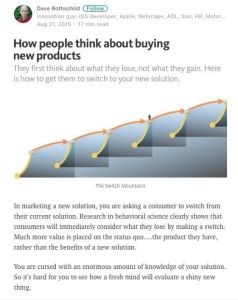
Dave Rothschild
How People Think About Buying New Products
They first think about what they lose, not what they gain. Here is how to get them to switch to your new solution.
JTBD, 2015
What's inside?
Let the “Shift Mountain Hypothesis” help your company convert more customers to your product or service.
Recommendation
What makes consumers switch to a new product or service? In this compelling article, app developer and consultant Dave Rothschild unpacks the behavioral science behind consumer decision making and offers practical help for marketers working to get consumers to let go of their current solutions and embrace new ones. Rothschild’s step-by-step explanations of the behavioral science behind the switch may proceed too slowly at times, but getAbstract recommends his techniques to marketers looking for impactful, science-backed marketing strategies.
Take-Aways
- When consumers initially face the option of a new product or service, most prefer sticking with the status quo.
- Getting a customer to switch solutions to a given problem requires attending to the emotional dimension of their decision making.
- Marketing strategies which focus solely on the pluses of a new product or service underperform because they fail to address how consumers weigh risk and reward.
- Consumers’ decisions to switch products or services hinge on their perception of risk versus reward from their particular reference point.
- Marketing strategies which pay attention to perceived risks and show prospects how they can “minimize” those risks are more effective in shifting the consumer perspective to a position where the new solution appears preferable.
Summary
Why do consumers resist changing from their current products and services, even when the new solution presented is superior? Answering this question requires understanding that emotions drive consumer decision making. Too many marketers ignore this fact: For example, market researchers commonly ask people whether they’d be open to switching to a new solution in the future. But rational speculations regarding future actions rarely match consumers’ actual decisions, which are colored by emotions – especially fear.
“Switching solutions is more emotional than logical and rational. Consumers are not even aware of the emotional and mental processes at work influencing their decisions.”
People generally weight potential risk more than potential reward. Marketers can therefore assume that an opportunity to switch solutions – say, from an existing password management system to a new one – feels risky to the average consumer. This is why marketing strategies which focus solely on an offer’s pluses underperform: They fail to help consumers overcome their “loss aversion” and “status quo bias.”
“Marketing a new solution with a focus on the features and benefits misses the behavioral dynamics of how consumers evaluate benefits.”
The “Switch Mountain Hypothesis” suggests that consumers’ decisions to switch solutions are like getting them to climb from one outlook on a mountain to another higher up. When a consumer is considering whether to climb, they make that decision from a particular “reference point” – that is, their existing solution. Because consumers worry about risk and tend to assign more value to things they already possess, the initial comparison between the new and existing solutions is advantageous for the status quo.
“Consumer decision making for solution switching starts from a reference point (the current solution) and evaluates the gains and losses from that point. Losses are more painful than gains so they are weighted more than twice as heavily in the consumer’s mind. Design and market for this.”
However, marketers can slowly shift consumers’ perspectives from their initial reference point to a position where the new solution appears preferable. As crucial events occur in a consumer’s life – for example, a friend becomes a hacking victim – switching to a password management service which promises a better solution begins to appear less risky. Marketers can leverage these events by presenting the new solution as better and easier (“acquisition utility”), by providing additional information about the problem that the new solution solves (“availability heuristic”) and by encouraging the consumer to feel that by switching they will be less at risk from the problem than others (“optimism bias”).
About the Author
Dave Rothschild is an iOS app developer at Intel Corporation and is the CEO of three tech start-ups. He has served as an app developer and consultant for Apple, Netscape, AOL, Sun, HP and Motorola.
This document is restricted to personal use only.
My Highlights
Did you like this summary?
Read the articleThis summary has been shared with you by getAbstract.
We find, rate and summarize relevant knowledge to help people make better decisions in business and in their private lives.
Already a customer? Log in here.
















Comment on this summary